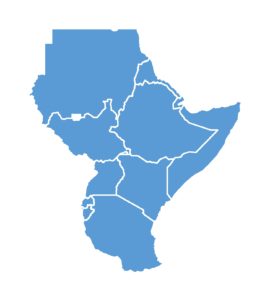CLIMATE FORECAST

The Climate Hazards Center (CHC) of the University of California Santa Barbara (https://www.chc.ucsb.edu/) provides GEOGLAM Crop Monitor with global and regional climate outlooks. These assessments are based on weather and seasonal climate forecasts from a variety of international and national sources. Regional climate outlooks in the CM4EW draw attention to abnormal rainfall and temperature conditions (observed and forecast) that may impact food production or pose other risks to society, with a focus on food insecure regions.
October 8th, 2020
PDF Download link
For previous reports visit the Archive.
Global Climate Influences:
Movement towards a La Niña-like climate by the end of the year
The El Niño-Southern Oscillation (ENSO) is currently in the La Niña phase. La Niña conditions are expected to continue from October to February (~85% chance) and potentially through February to April (~60% chance).
La Niña conditions typically reduce October to February/May rainfall in East Africa, the southern United States, the northern Middle East, and southern Central Asia. Southern Brazil, northern Argentina, eastern China, the Korean Peninsula, and southern Japan typically see reduced rainfall into January. La Niña conditions typically increase October to February/May rainfall in Southeast Asia, Southern Africa, southern Central America, northern South America, and in southernmost India and Sri Lanka. Australia and Indonesia typically see increased rainfall into December.
Additionally, a negative Indian Ocean Dipole may be at the beginning stage. A negative Indian Ocean Dipole typically reduces rainfall in East Africa and increases rainfall in parts of southern and central Australia.
Regional Outlooks:
 East Africa
East Africa
Above-average rainfall is expected to continue across much of the region through September
The East Africa long rains season consists of a tropical rain-band that generally presides over the southern half of the region in March-April-May (MAM) before gradually moving to the north for June-July-August-September (JJAS). This year, record rainfall throughout the long rains season (Figure 1-middle) saturated soils and brought rivers, lakes, and dams to unprecedented levels, which resulted in widespread flooding and provided favourable conditions for desert locusts. Most recently, September rainfall exceeding 120% of average resulted in flooding in South Sudan, southwestern and the Afar region of northern Ethiopia, Uganda, and the Democratic Republic of the Congo (Figure 1-left).
Below-normal rainfall conditions are anticipated in much of the region for the October-November-December (OND) short rains and Somalia’s September to November Deyr season. Seasonal forecasts from NMME (Figure 1-right) and the Greater Horn of Africa 56th Climate Outlook Forum indicate an increased likelihood of below-normal OND rainfall throughout the region (See Seasonal Forecast Alert pg. 5). According to SubX 30-day forecasts, eastern areas will see drier-than-average conditions beginning in October, while parts of Uganda and South Sudan will see wetter-than-average conditions continue for the next several weeks.

Estimated percent-of-average anomaly for August 26th to September 25th, estimated rainfall rank since March 1st, and a 3-month probabilistic rainfall forecast for October to December. The left and middle panels are UCSB Climate Hazards Center Early Estimates, which compare 2020 rainfall amounts to the CHIRPS historical record (1981-2019). The left panel indicates the estimated percent-of-average anomaly for August 26th to September 25th. The middle panel ranks the March 1st to September 25th, 2020, total relative to historical totals for the same period, and indicates where the current season is within the three wettest or three driest years on record. The right panel is a 3-month NMME probabilistic forecast for October to December based on September conditions. The forecast probability is calculated as the percentage of all 79 NMME ensemble members that fall in a given tercile (above/below/near normal).
 West Africa
West Africa
Average to above-average rainfall forecast through October
Late-August to late-September rainfall levels were overall above-average throughout much of the region (Figure 1-left). This further contributed to the average to above-average rainfall totals seen since June over the Sahelian and Sudanian-Guinean zones (Figure 1-middle). While this produced generally favourable conditions for cropping and pastoral practices, above-average rainfall resulted in localized flooding, particularly in Chad, Nigeria, Niger, Senegal, Burkina Faso, and Ghana. Conversely, the bimodal zone—which consists of the southern coastal portions of Liberia, Côte d’Ivoire, Ghana, Togo, Benin, and Nigeria—was affected by a prolonged spell from July to August. These dry conditions continued through September for much of the bimodal zone with rainfall less than 80% of average in Ghana, Togo, Benin, and Nigeria. In contrast, September rains were above-average in Liberia and Côte d’Ivoire.
The 30-day forecast indicates rainfall is expected to be average in the north, and above-average in the south (Figure 1-right). The above-average rainfall predicted in the bimodal zone indicates a late but likely favourable start to the minor season.

Figure 1. Estimated percent-of-average anomaly for August 26th to September 25th, estimated percent-of-average anomaly since June 1st, and a 30-day rainfall anomaly forecast from September 24th. The left and middle panels are UCSB Climate Hazards Center Early Estimates. They compare 2020 rainfall amounts to the 1981-2019 CHIRPS average. The right panel is a 30-day forecast from September 24th. The image shows the average of five Subseasonal Experiment (SubX) model forecasts from that day. The anomaly is based on the 1999 to 2016 model average. Skill assessments of SubX can be accessed here.
 Southern AfricaOctober through February rainfall is likely to be average to above-average across Southern Africa
Southern AfricaOctober through February rainfall is likely to be average to above-average across Southern Africa
Based on recent forecast products, the start of the 2020-2021 rainfall season in Southern Africa is likely to be normal with near-average rainfall likely throughout the region in October. Seasonal forecasts, based on September conditions, indicate near-normal cumulative rainfall for most areas during October to December and increased chances for above-normal December-to-February rainfall—the critical rainfall period for cereal crops in much of Southern Africa (Figure 1). La Niña conditions are currently present and likely to remain through the start of 2021. Historically, La Niña conditions typically result in above-normal precipitation between October and April in Southern Africa, although regional factors such as the phase of the Subtropical Indian Ocean Dipole (SIOD) can moderate the influence of La Niña in the region. As such, it would be prudent to continue to monitor seasonal progress for this region.

Figure 1. 3-month NMME probabilistic forecast for December to February, based on September conditions. The forecast probability is calculated as the percentage of all 79 NMME ensemble members that fall in a given tercile (above/below/near normal). White color indicates there is no dominant category across the model forecasts. NMME image from NOAA CPC.
 Southeast Asia
Southeast Asia
Likelihood of above-average rainfall through the October to December rainfall period
Rainfall from late-August to late-September was average to slightly below-average across much of the northern parts of the region with rainfall totals ranging from 40-80% of average in western Myanmar, north-central Thailand, central Laos, Vietnam, and the Philippines. In contrast, rainfall was average to above-average in the southern half of the region, including rainfall totals exceeding 200% of average in southern Thailand, Malaysia, and Indonesia (Figure 1-left). This spatial pattern of slightly below-average rainfall in the north and above-average rainfall in the south is consistent with the seasonal rainfall anomaly since April 1st (Figure 1-middle). However, given the sufficient rainfall experienced in this region over the course of a growing season, these slight deficits in the north are unlikely to have adverse effects on production in the area which is about halfway through its primary rice season.
The 3-month forecast indicates an increased likelihood of above-normal rainfall in Thailand, Laos, Vietnam, the Philippines, and Indonesia, providing favourable growing conditions throughout the region (Figure 1-right).

Figure 1. Estimated percent-of-average anomaly for August 26th to September 25th, estimated percent-of-average anomaly since April 1st, and a 3-month probability forecast. The left and middle panels are UCSB Climate Hazards Center Early Estimates. They compare 2020 rainfall amounts to the 1981-2019 CHIRPS average. On the right is the 3-month NMME experimental probabilistic forecast for October to December, 2020, based on September conditions. The forecast probability is calculated as the percentage of all 79 NMME ensemble members that fall in a given tercile (above/below/near normal).
 Central America & Caribbean
Central America & Caribbean
Above-average rainfall expected to continue across the region through October to December
Seasonal rainfall totals since the start of August have been near-average (Figure 1-middle), despite sporadic rainfall from late-August to late-September, with rainfall totals less than 80% of average in Belize, eastern El Salvador, eastern Honduras, eastern Nicaragua, Cuba, and Haiti (Figure 1-left).
The 3-month forecast indicates an increased likelihood of above-normal precipitation throughout Central America and Haiti and is inconclusive for Cuba. The prevailing La Niña ENSO conditions suggest a likelihood of an above-normal hurricane season in the Caribbean. Hurricane Delta formed in the Caribbean Sea on October 5th and passed by the west coast of Cuba, bringing heavy rains and winds before moving towards the Gulf Coast of the United States.

Figure 1. Estimated percent-of-average anomaly for August 26th to September 25th, estimated percent-of-average anomaly since August 1st, and a 3-month probability forecast. The left and middle panels are UCSB Climate Hazards Center Early Estimates. They compare 2020 rainfall amounts to the 1981-2019 CHIRPS average. On the right is the 3-month NMME experimental probabilistic forecast for October to December, 2020, based on September conditions. The forecast probability is calculated as the percentage of all 79 NMME ensemble members that fall in a given tercile (above/below/near normal).
For previous forecasts and assessments, please see the report archive page.

